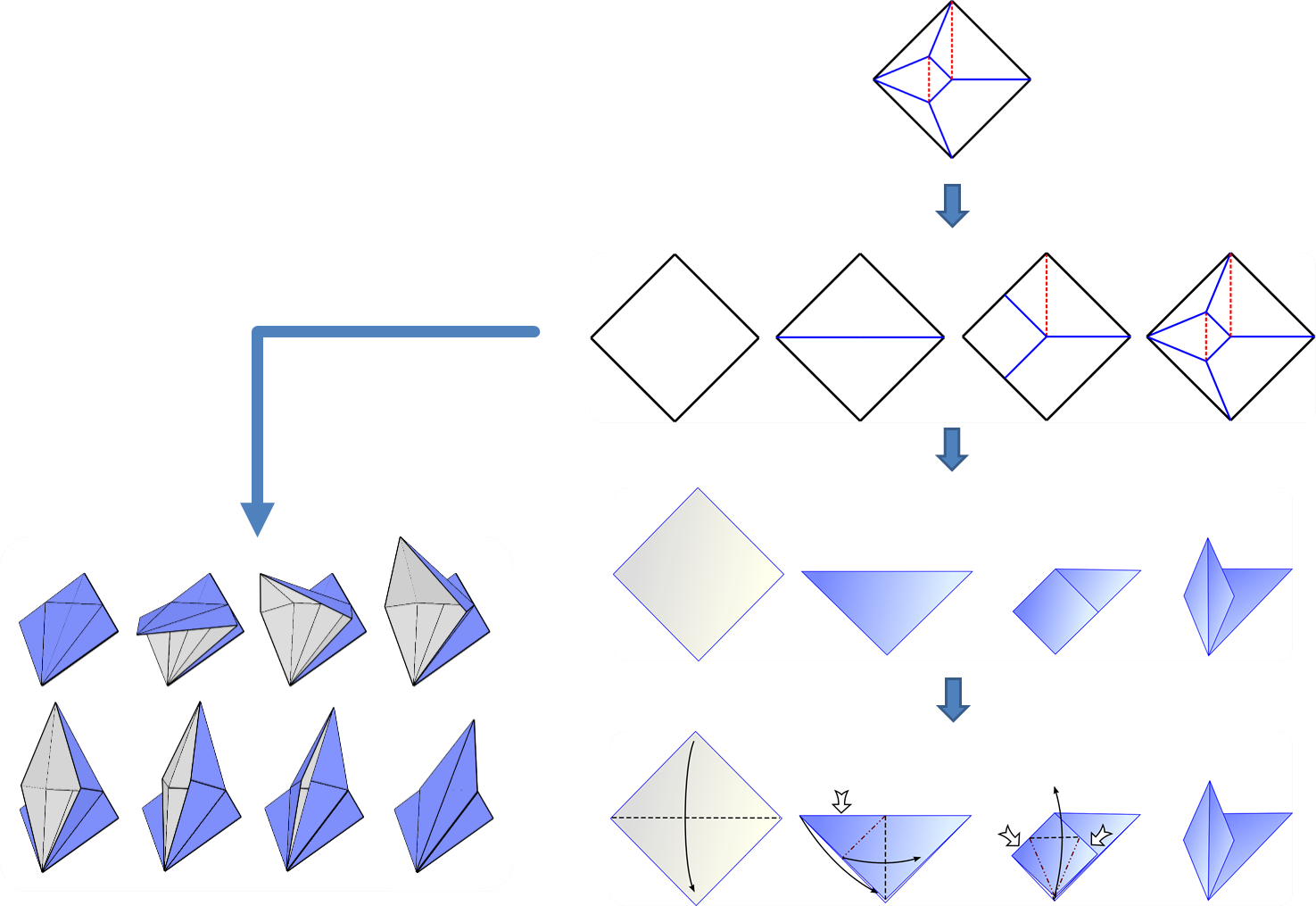Generating Origami Folding Sequences from Flat-Foldable Crease Patterns

Crease Pattern and folded form of an origami penguin, from left to right respectively. Model by Hideo Komatsu, images redrawn by the authors.

A sequence of crease patterns is created from the input crease pattern. It is, then transformed into a sequence of folded forms that is the base for the origami diagrams.

The graphic user interface of ORIZU.
Abstract
Origami is the Japanese art of constructing geometric shapes from paper folding. Origami diagrams are step-by-step instruction on how to fold an origami. They are composed of figures that represent the state of the folded paper, in combination with lines and arrows indicating the position of the folds and the movement of the paper. The most common form to document origami pieces is through origami diagrams, because they are relatively easy to be followed. The notation used in these diagrams transcends language barriers and, for that reason, origami has spread around the world. Variations of this same kind of notation are largely used until now. With the development of modern techniques of origami design, the range of achievable shapes has increased drastically and origami models became detailed and complex. In this context, the crease pattern (the pattern of creases left on the paper after folding an origami model) has gained importance as an efficient method of documenting origami. A crease pattern shows the entire origami structure of folds in just one picture. Furthermore, many of those modern techniques use mathematical theories developed for crease patterns and, therefore, produce crease patterns as their result. However, the disadvantage of this representation is that it is very difficult to fold the origami model in actual paper using only the crease pattern. Crease patterns show only where each crease must be made and not their order or how the paper must be folded. The purpose of this work is to assist the creation of origami diagrams from crease patterns. We introduce a system named ORIZU that, as input, receives an origami model in the form of a crease pattern. It, then, generates some of the possible folding sequences that will result in the desired model. To achieve that, the system constructs a graph that represents the input crease pattern and uses graph rewriting as a model for origami folding techniques. First, a graph rewriting rule is assigned for each origami technique. This rule describes the changes that occur in the crease pattern when the corresponding folding technique is undone. The unfolding of an origami step, then, corresponds to a graph rewriting step. Thus, the origami can be simplified gradually. It expected that, eventually, the successive simplifications will result in the empty crease pattern. The final results are obtained by reversing the simplification sequence, thus obtaining a sequence that goes from the unfolded paper to the desired model. This system can help people who are inexperienced in folding crease patterns as well as semi-automatize the time-consuming task of drawing diagrams. The mathematical modeling proposed here also contributes with the categorization and further studies of new origami techniques, as well as with some mathematical origami problems such as simply foldability of an origami pattern.
Video
Publication
- Hugo AKITAYA, Jun MITANI, Yoshihiro KANAMORI and Yukio FUKUI, “Origami Diagrams and 3D Animation from Flat-Foldable Crease Patterns Sequences”, International Conference on Simulation Technology(JSST), Tokyo, (2013) (Outstanding Presentation Award)
- Hugo AKITAYA, Jun MITANI, Yoshihiro KANAMORI and Yukio FUKUI, “Generating Folding Sequences from Crease Patterns of Flat-Foldable Origami”, ACM SIGGRAPH 2013 Posters, Anaheim, CA. 2013. (First Place in the Student Research Competition)
- Hugo AKITAYA, Jun MITANI, Yoshihiro KANAMORI and Yukio FUKUI, “Creating Folding Sequences from Origami Crease Patterns”, VC/GCAD合同シンポジウム2013. 青森, (2013).
- Hugo AKITAYA, Jun MITANI, Yoshihiro KANAMORI, Yukio FUKUI, "Step-by-step folding sequences from origami crease patterns using graph rewriting", 2012年度日本図学会秋季大会, 東京, 2012/12/15-16.
- Hugo AKITAYA, Jun MITANI, Yoshihiro KANAMORI and Yukio FUKUI, "Finding a folding sequence for an origami crease pattern using graph pattern matching", Dynamics and Design Conference, 神奈川, Proceedings No.819 (2012).
